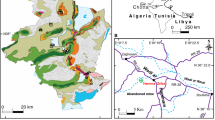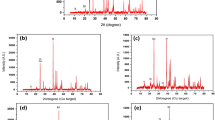Abstract
The extraction of gold ore generates rejects called gold mining reject (GMR). This reject is considered a major environmental problem for the mining industry. In Amesmessa mine (Hoggar, Algeria), where mining have been carried out for over 15 years, about 2 million tons of mill tailings has been accumulated each year. The aim of this work is to study the reuse of GMR as raw material in ceramic field and its effect on microstructure, color, and mechanical and chemical properties. During investigation, the results show that GMR is mainly composed of quartz, hematite, pyrite, and dolomite. During sintering, mullite, quartz, anatase, and rutile were the mineralogical phases which composed the ceramic samples. As the temperature rises at 1200 °C, peaks of mullite increased, beside rutile and quartz phases. When 30 wt% of the reject was added, the crystalline phases as quartz and mullite diminished, giving rise to the glassy phase formation that is promoted by metal oxides playing a role as fluxing agents. Elastic property as Young’s modulus of the samples increased from 09.35 to 15.93 GPa and from 19.66 to 60.94 GPa at 1100 °C and 1200 °C respectively. The environmental study of the incorporation of GMR in ceramic matrix, rich in heavy metals (Fe, Zn, Ni), was evaluated by leaching tests of the fired products. The results indicated a successful immobilization of the heavy metals. These results suggested the use of gold mining reject in the ceramic field, as a substituent of feldspar, and might be an alternative and reliable method for the disposal of this reject.







Similar content being viewed by others
Data availability
All data generated or analyzed during this study are included in this published article (and its supplementary information files).
References
Aduda BO, Nyongesa FW (2000) Role of aspect ratio in elastic modulus–porosity relationship of triaxial porcelain. Br Ceram Trans 99:206–211. https://doi.org/10.1179/096797800680956
Batista SAF, Messer PF, Hand RJ (2001) Fracture toughness of bone china and hard porcelain. Br Ceram Trans 100:256–258. https://doi.org/10.1179/bct.2001.100.6.256
Belnou F (2002) Mullitization and shrinkage inhibition in multi-oxide, alumina-zircon and aluminous porcelain systems, the national polytechnic institute of Grenoble. (in French)
Baudin C, Villar MP (1998) Influence of thermal aging on microstructural development of mullite containing alkalis. J Am Ceram Soc 81:2741–2745. https://doi.org/10.1111/j.1151-2916.1998.tb02690
Bouzidi N (2012) Influence of kaolin impurities on properties, the University of Bejaia, École Supérieure des Mines de. Process Engineering, Saint (in French)
Bouzidi N, Bouzidi A, Gaudon P, Merabet D, Blanchart P (2013) Porcelain containing anatase and rutile nanocrystals. Ceram Int 39:489–495. https://doi.org/10.1016/j.ceramint.2012.06.053
Bouzidi N, Aissou S, Concha-Lozano N et al (2014a) Effect of chemico-mineralogical composition on color of natural and calcined kaolins. Color Res Appl 39:499–505. https://doi.org/10.1002/col.21813
Bouzidi N, Bouzidi MA, Bouguermouh K, Nunes RO, Benabdeslem N, Mahtout L, Merabet D (2014b) Mechanical and dielectric properties of high temperature coating insulators based on by-product of Algerian kaolin. Trans Indian Ceram Soc 73:277–283. https://doi.org/10.1080/0371750X.2014.926782
Bradley RJ, Waltraud MK, Schneider J (2001) Crystal structure development during devitrification of quenched mullite. J Eur Ceram Soc 21:2541–2562
Brindley G, Nakahira M (1959) The kaolinite–mullite reactions series-I. A survey of outstanding problems. J Am Ceram Soc 42:311–324. https://doi.org/10.1111/j.1151-2916.1959.tb14314
Cannillo V, Esposito L, Rambaldi E, Sola A, Tucci A (2009) Effect of porosity on the elastic properties of porcelainized stoneware tiles by a multi-layered model. Ceram Int 35:205–211. https://doi.org/10.1016/j.ceramint.2007.10.015
Çelik Ö, Elbeyli IY, Piskin S (2006) Utilization of gold tailings as an additive in Portland cement. Waste Manag Res 24:215–224. https://doi.org/10.1177/0734242x06064358
Cukrowska EM, Govender K, Viljoen M (2004) Ion mobility based on column leaching of South African gold tailings dam with chemometric evaluation. Chemosphere 56:39–50. https://doi.org/10.1016/J.chemosphere.2004.01.036
Dana K, Das SK (2004) Evolution of microstructure in fly ash-containing porcelain body on heating at different temperatures. Bull Mater Sci 27:183–188. https://doi.org/10.1007/bf02708503
Dana K, (2007) Utilization of some industrial waste materials in the triaxial composition for the preparation of ceramic tiles. Br. Ceram. http://cgcri.csircentral.net/id/eprint/3249. Accessed March 2020
Deniel S, Tessier-Doyen N, Dublanche-Tixier C et al (2010) Processing and characterization of textured mullite ceramics from phyllosilicates. J Eur Ceram Soc 12:2427–2434. https://doi.org/10.1016/j.jeurceramsoc.2010.04.029
De Noni A, Hotza D, Soler VC et al (2010) Influence of composition on mechanical behavior of porcelain tile Part II: mechanical properties and microscopic residual stress. Mater Sci Eng A 527:1736–1743. https://doi.org/10.1016/j.msea.2009.10.0603
Fuji M, Tsuchimoto J, Takai C, Goto R, Irie M, Tarhouni J (2017) Adaptability of sediment from Joumine reservoir, Tunisia, as a ceramic raw material. Euro-Mediterr J Environ Integr 2:26. https://doi.org/10.1007/s41207-017-0037-6
Harabi A, Guerfa F, Harabi E et al (2016) Preparation and characterization of new dental porcelains, using K-feldspar and quartz raw materials. Effect of B2O3 additions on sintering and mechanical properties. Mater Sci Eng C 65:6533–6542. https://doi.org/10.1016/j.msec.2016.03.067
Jeoung-Ah K (2004) The characterization of paper composite porcelain in a fired state by XRD and SEM. J Eur Ceram Soc 24:3823–3831. https://doi.org/10.1016/j.jeurceramsoc.2004.03.002
Johnson SM, Pask JA (1982) Role of impurities on formation of mullites from kaolinite and Al2O3-SiO2 mixtures. Am Ceram Soc Bull 61:838–842
Kingery WD (1976) Introduction to Ceramics. J. Wiley & Sons, New York
Lee WE, Souza GP, McConville CJ et al (2008) Mullite formation in clays and clay-derived vitreous ceramics. J Eur Ceram Soc 2:465–471. https://doi.org/10.1016/j.jeurceramsoc.2007.03.009
Maiti KN, Kumar S (1992) Microstructure and properties of a new porcelain composition containing crystallizing glasses as replacement for feldspar. Br Ceram Trans J 91:19–24 http://cgcri.csircentral.net/id/eprint/2335
Martín-Márquez J, Rincón JM, Romero M (2010) Effect of microstructure on mechanical properties of porcelain stoneware. J Eur Ceram Soc 30:3063–3069. https://doi.org/10.1016/j.jeurceramsoc.2010.07.015
Murray HH (2000) Traditional and new applications for kaolin, smectite, and paligorskite: A general overview. Appl Clay Sci 17:207–221. https://doi.org/10.1016/S0169-1317(00)00016-8
Muan A (1957) Phase equilibrium relationships at liquidus temperatures in the system FeO-Fe2O3-Al2O3-SiO2. J Am Ceram Soc 40:420–431. https://doi.org/10.1111/j.1151-2916.1957.tb12566
Murthy MK, Hummel FA (1960) X-ray study of the solution of TiO2, Fe2O3 and Cr2O3 in mullite (3Al2O3.2SiO2). J Am Ceram Soc 43:267–273. https://doi.org/10.1111/j.1151-2916.1960.tb14595
Novais RM, Seabra MP, Labrincha JA (2015) Wood waste incorporation for lightweight porcelain stoneware tiles with tailored thermal conductivity. J Clean Prod 90:66–72. https://doi.org/10.1016/j.jclepro.2014.11.045
Oliveira APN, de Vilches ES, Soler VC, Villegas FAG (2012) Relationship between Young’s modulus and temperature in porcelain tiles. Eur Ceram Soc 32:2853–2858. https://doi.org/10.1016/j.jeurceramsoc.2011.09.019
Paktunc D, Foster A, Heald S, Laflamme G (2004) Speciation and characterization of arsenic in gold ores and cyanidation tailings using X-ray absorption spectroscopy. Geochim Cosmochim Acta 68:969–983. https://doi.org/10.1016/j.gca.2003.07.013
Rambaldi E, Pabst W, Gregorová E et al (2017) Elastic properties of porous porcelain stoneware tiles. Ceram Int 43:6919–6924. https://doi.org/10.1016/j.ceramint.2017.02.114
Ribeiro MJ, Tulyagavov DU, Ferreira JM, Labrincha JA (2005) High temperature mullite dissolution in ceramic bodies derived from Al-rich sludge. J Eur Ceram Soc 25:703–710. https://doi.org/10.1016/j.jeurceramsoc.2004.03.028
Roy S, Adhikari GR, Gupta RN (2007) Use of gold mill tailings in making bricks: a feasibility study. Waste Manag Res 25:475–482. https://doi.org/10.1177/0734242X07076944
Santos RLP, Silva FS, Nascimento RM et al (2016) On the mechanical properties and microstructure of zirconia-reinforced feldspar-based porcelain. Ceram Int 42:14214–14221. https://doi.org/10.1016/j.ceramint.2016.05.195
Sivaldo LC et al (2008) Effect of quartz sand replacement by agate rejects in triaxial porcelain. Hazard Mater 163:315–322. https://doi.org/10.1016/j.jhazmat.2008.06.094
Soro NJ, Aldon L, Jumas JC, Blanchart P (2003) Iron role on mullite from kaolin by Mӧssbauer spectroscopy and Rietveld simulation. J Am Ceram Soc 86:129–134. https://doi.org/10.1111/j.1151-2916.2003.tb03289
Van Noort R. (2002) Dental Ceramics, introduction to dental materials. Edition 2, Mosby, UK.
Zagury G, Oudjehani K, Deschenes L (2004) Characterization and availability of cyanide in solid mine tailings from gold extraction plants. Sci Total Environ 320:211–224. https://doi.org/10.1016/j.scitotenv.2003.08.012
Author information
Authors and Affiliations
Contributions
AB (PhD student) has sampled the reject in the Amesmessa mine (Algeria), analyzed, and interpreted the results. NB performed the scientific work and was a major contributor in writing the manuscript. DEQ provided instrumentation and reagents in the laboratory, contributed in writing the manuscript (Jaen University, in Spain), and helped in English writing. All authors read and approved the final manuscript.
Corresponding author
Ethics declarations
Conflict of interest
The authors declare that they have no conflict of interest.
Additional information
Responsible Editor: Philippe Garrigues
Publisher’s note
Springer Nature remains neutral with regard to jurisdictional claims in published maps and institutional affiliations.
Rights and permissions
About this article
Cite this article
Baziz, A., Bouzidi, N. & Eliche-Quesada, D. Recycling of gold mining reject from Amesmessa mine as ceramic raw material: microstructure and mechanical properties. Environ Sci Pollut Res 28, 46738–46747 (2021). https://doi.org/10.1007/s11356-020-12017-y
Received:
Accepted:
Published:
Issue Date:
DOI: https://doi.org/10.1007/s11356-020-12017-y




